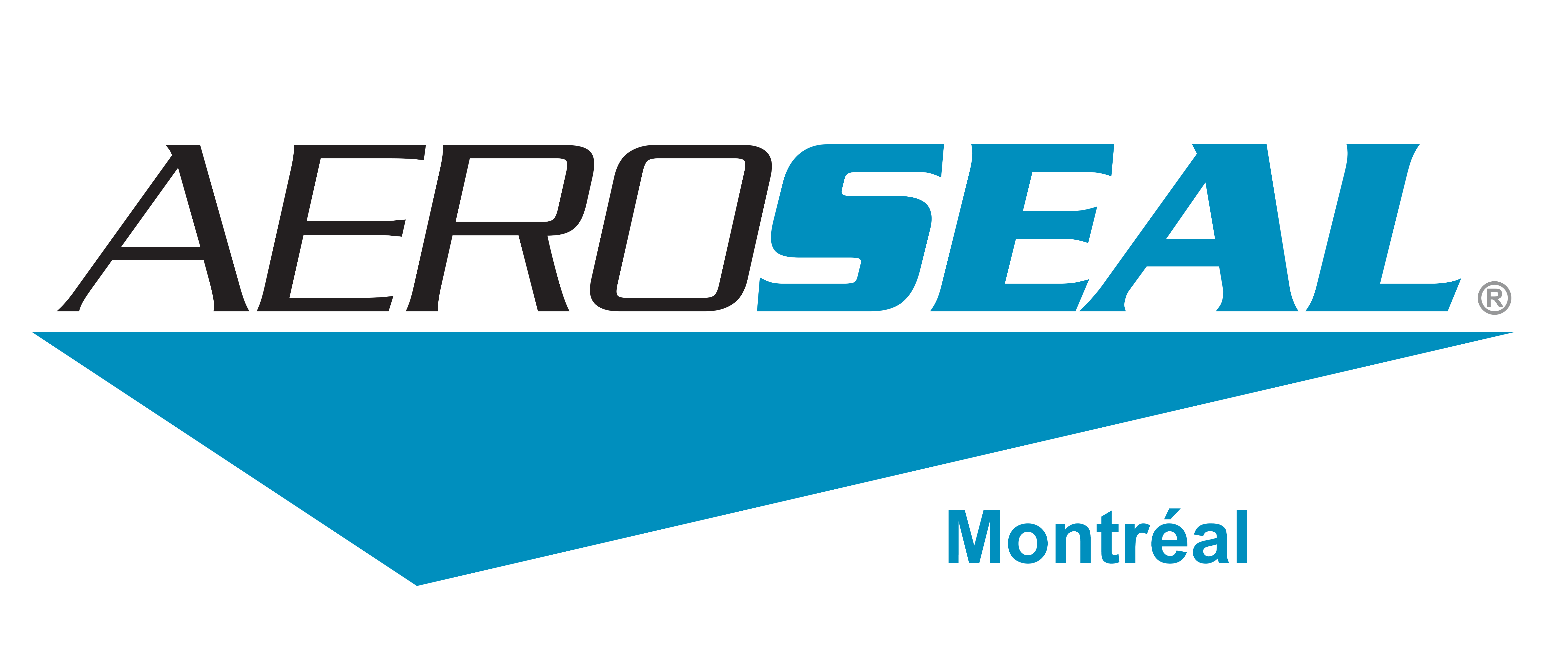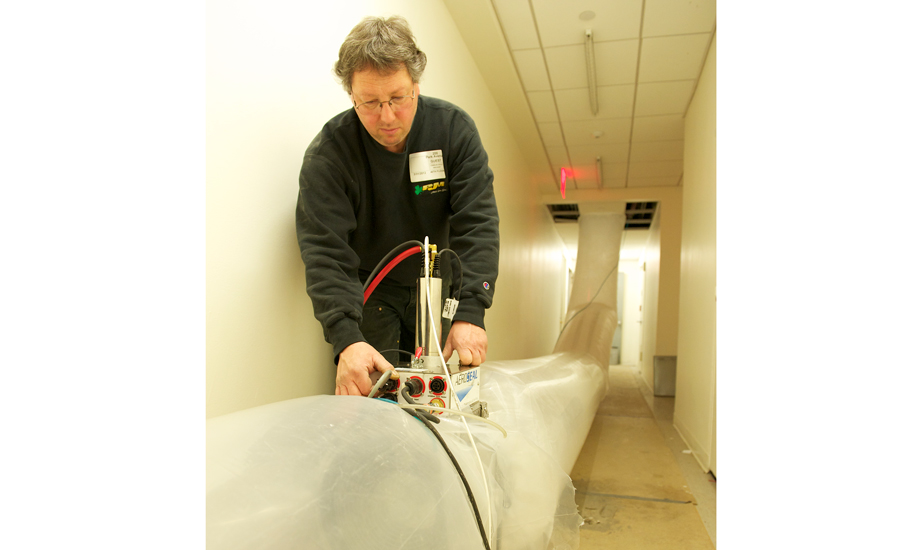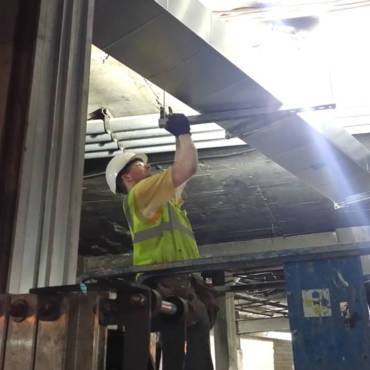Reducing energy consumption has become a standard practice among commercial building owners and facility managers given the potential for energy cost savings. State and local regulations are driving new building construction as well as existing buildings to implement energy-efficient technologies in order to meet future carbon emissions reduction goals. These facilities, known as high-performance buildings, strive to deliver optimal efficiency, reliability, value, and comfort to tenants.
There is one key obstacle when it comes to the adoption of high-performance buildings, according to Neal Walsh, senior vice president, commercial markets, Aeroseal LLC, and that is cost.
“It comes down to dollars per square foot and finding that right mix of attributes that will provide cost-effective results,” he said. “This can be quite a challenge. On the positive side, increased demand and breakthrough technologies are helping drive down the price of materials and reduce labor costs. We are already seeing industry-changing innovations, such as aerosol-based duct sealing, being used by contractors as a standard practice on all their building projects.”
Public education is still key to the adoption of energy-efficient buildings, but in many cases, the message needs to change, said Amit Gupta, CEO, Aeroseal. “Rather than focus on cost savings, the industry needs to draw a clear connection between energy-efficient buildings and comfort, health, safety, and worker productivity. To adopt energy-efficient practices, a contractor has to find that right mix of attributes that can be cost-effective for a high-performance building. The market is maturing, and a lot of technologies are becoming more affordable than they have ever been, and that’s helping drive demand.”
INCREASED CONNECTIVITY
According to Tyler Haak, business development manager, EcoBuildings Division, Schneider Electric, the current trends in high-performance buildings reflect peoples’ everyday lives.
“Our lives are becoming a lot more digital and more connected,” he said. “If you think of the way you live your life, your music used to be on CDs, and now it’s digital; you once hailed a taxi cab with cash on the street corner, and now it’s done on an app. Our lives are moving in that direction, and we spend most of our time indoors, so we’re seeing that more and more people are looking to interact with their buildings in a much more interactive way.
“When we look at big data and all of the information in a building that lends itself to big data, you can’t master what you can’t measure,” Haak continued. “So, the more things we’re connecting, the more things we’re digitalizing, and the better grasp we feel we have on what’s happening in buildings and what can be done to improve their performance.”
For buildings in general, it’s all moving toward the Internet of Things (IoT) and big data, added Jon Stefkovich, intelligent buildings solutions sales, Schneider Electric.
“High-performance buildings are specifically using big data for energy-efficiency purposes but also as a recruiting tool to bring in talent and get people to want to work at their facilities,” he said.
Lisa Tryson, director of corporate communications for Danfoss, said there is definitely more of a focus on connectivity in the high-performance building sector.
“Building energy efficiency achieved from improved component efficiencies is reaching its physical limits, there is an increasing turn to whole-building integrative design between systems and subsystems,” she said. “Similarly, products and design are focusing more on connectivity.”
INTEROPERABILITY AND OPTIMIZATION
Brian Bogdan, director of engineering, LG Electronics Inc., said the current high-performance building trend is interoperability and cohesiveness.
“The trend continues to focus on interoperability and efficiency, making the building’s systems work cohesively to improve the occupant’s experience while optimizing the functionality,” Bogdan said. “It starts by creating highly efficient products and then layering solutions that not only record data but make the data actionable to improve the performance of the building. It is for this reason that LG continues to increase the energy efficiency of its VRF [variable refrigerant flow] technology and why we launched the MultiSITE controls platform.”
Ian Dempster, senior director of product innovation, Optimum Energy, agreed, saying big data and optimization are two of the largest trends he is seeing.
“Big data from a building and its systems allow us to start at the source of a problem and analyze the relevant information and operational data to figure out the best solution,” Dempster said. “Additionally, big data, in conjunction with cloud computing technology and machine learning, can create opportunities for improved building and system models, dynamic tests, and up-to-date alerts regarding on-site conditions. However, there’s a big difference between software and other technological capabilities and their applications in buildings. Buildings are not yet taking full advantage of the tools available.
“The industry is becoming more aware of the need to focus on optimization of entire systems and not just the individual components of a building,” he continued. “Easily installable and integratable optimization products that focus on entire system optimization are becoming more common in existing buildings to improve performance and efficiency.”
Dempster also noted that sharing and comparing energy uses is becoming more common as more than 30 major cities around the country have laws requiring commercial building owners to disclose actual building performance.
“This trend will continue to spread as the easiest way to monitor reductions in carbon emissions from commercial and governmental buildings,” he said. “We have been seeing the trend with some of our larger enterprise clients, who are having quarterly and sometimes monthly meetings where all facility managers and operators compare the operation and efficiency state of their buildings with our OptiCx Building Energy Dashboard, discussing any issues they may have and sharing best practices from the higher performing facilities.”
ZERO NET ENERGY
Another major trend facing the high-performance building industry is the push toward zero net energy (ZNE).
According to a report released by the New Buildings Institute (NBI), there are currently 332 buildings that have been either verified as or are on their way to achieving ZNE. That’s a 74 percent increase over last year’s data. Additionally, 53 projects have now been verified by NBI as having achieved ZNE for at least one full year, which is up from 33 projects in 2014.
“For many years, high performance was commonly known as energy efficient,” said Clay Nesler, vice president, global sustainability and industry initiatives, Johnson Controls Inc. “With the introduction and popularity of green building rating systems, high performance came to signify a broader range of resource efficiency, indoor environmental quality, and site characteristics. Two emerging trends include a greater focus on occupant health and wellness and the development of low-carbon or net-/near-zero energy buildings and communities. In our 2016 Energy Efficiency Indicator study of more than 1,200 organizations in five countries, 80 percent plan to have one or more near-zero, net-zero, or energy positive buildings in the future. More organizations plan to have at least one certified green building in the future.”
Washington, District of Columbia, has issued a sustainability plan that calls for a 50 percent reduction in greenhouse gas emissions and retrofitting 100 percent of existing commercial and multifamily buildings to achieve net-zero standings by 2032, noted Stefkovich.
“With that plan put forth back in 2012, construction now has it in mind, and the first wave of these net-zero buildings are coming out,” Stefkovich said. “They are setting the blueprint, so they can achieve that energy standard by 2032. In this marketplace, there is a growing demand that stems from this mandate for net-zero buildings.”
“Additionally, there was an executive order issued where 15 percent of all existing federal buildings need to conform to new energy-efficiency standards, and 100 percent of all new federal buildings need to be zero-net energy by 2030,” Haak added. “Also, Forbes is reporting that California is pursuing 100 percent renewable energy by 2045. If you consider those things along with the Paris Climate accord, and the Architecture 2030 challenge, groups like the U.S. DOE [Department of Energy] or Lawrence Berkley National Laboratory are emphasizing and driving this upfront. I feel that is a huge point that moves us toward the demand for net-zero buildings. Yes, it’s being driven through regulations, but its also attractive.”
Walsh said the demand for ZNE buildings is just beginning to surface in the U.S.
“Making it mainstream is going to require a reduction in the cost, and that starts with the contractors,” he said. “We are going to have to train contractors to use standard materials and standard practices to get as close to net zero as possible. While innovations are helping in this regard, we can’t wait for new fancy technologies. It can be — and is being — done today, but it takes two things: architects and engineers who are really looking at energy when they do the basic design and holding contractors accountable to do what they say they are going to do.”
Dempster agreed that while there is a demand for ZNE buildings, it’s a low demand.
“It’s a case of nice to have, but not necessary,” he said. “Typically, net-zero buildings are the result of a building owner who has deep pockets and a focus on sustainability. They’re located in areas or cities where sustainability is well received by the populace. As sustainability and green practices become more common and accepted, we will see the demand rise. Right now, additional focus should be on improving existing buildings with better renovation practices, improved building efficiency, and sustainable operating practices to create more efficient high-performance buildings.
“A net-zero energy goal is possible now in new construction and in some more modern commercial buildings, though it’s generally a high-cost option,” he continued. “This goal will become more widespread as better building software, equipment technologies, and breakthroughs occur. There will always be buildings whose ages and initial designs make it almost impossible to convert them to net-zero energy without major rebuilds and total equipment upgrades, but that does not mean they cannot have lofty sustainability goals, achievable by upgrading and improving them over time, starting with modern control systems and optimization of their existing equipment and systems.”
Marc Braun, president of Cambridge Engineering Inc., said big players, like REI, Best Buy, Amazon, and Tesla, are currently looking for the energy- and cost-savings initiatives ZNE can bring.
“REI and McCormick [the spice company] have both earned net-zero status for their distribution centers; it’s a matter of combining renewables, such as solar, with high-temperature heating and ventilation [HTHV] equipment and other energy-efficient building systems,” Braun said. “All it takes is for building owners and facility planners to say, ‘Yes, I want it.’ So while ZNE for commercial buildings is definitely achievable, it remains rare. Only 110 U.S. buildings have the designation. We can do so much better. We really think it’s time for a movement in the building and HVAC industry toward net zero. Everyone wants to save energy and reduce their utility bills, and this is a great place to start.”
Mark Ritz, commercial business unit manager, Rheem Mfg. Co., said there is currently a lot of talk about ZNE.
“There is a lot of discussion about net-zero buildings but not a great deal of demand from building owners and specifying engineers,” Ritz said. “My assumption is that the first cost is too high, and owner awareness is low. From the HVAC perspective, the most prevalent trends continue to be focused around dehumidification technology, primarily in the eastern part of U.S., as well as the utilization of variable frequency drives [VFDs], which allow for multiple stages of airflow to increase efficiency and comfort.”
Stephen Yurek, president and CEO, Air-Conditioning, Heating and Refrigeration Institute (AHRI), sees ZNE buildings as more of an aspiration.
“It’s fine to have an aspiration, and I see net zero as an aspiration, but then you have to look at what delivers what message,” Yurek said. “Will people buy into it? And, I mean, people other than those who are already going to adopt the latest technology — they’re going to invest in net zero, of course. But others are going to be looking at more economical viewpoints. What we need to do is say, ‘Yes, we can aspire to net zero.’ But what we’re really talking about is any new or existing building can use energy wisely and efficiently and do it in the most cost-effective manner — and that is what we should be really aiming for versus net zero. People will look at this and think it means they have to spend all this money, so then they don’t do anything. They think it’s too far out there, or it will be too expensive. But, there are a lot of things people can do in an existing building to make it more energy efficient and to use energy better and more wisely.
“One way to save energy is to properly maintain the systems they have today,” he continued. “Other options include replacing older systems with more efficient equipment. Most of us understand we have a lot of great equipment in this industry that goes from federal minimums to way above in terms of performance and energy efficiency, but what really dictates the energy use in that building is the structure in which that mechanical system is placed. And that is something we don’t have any control over. We don’t have control over the actual structure, windows, insulation, or roof. And those types of things really have a much greater impact on energy use and the need for cooling or heating capacity than mechanical systems themselves. It’s great having the net-zero tag, but you need to provide it in deliverable pieces so that people actually start moving, installing, and maintaining their systems to decrease the energy use in the building.”
CHALLENGES
While regulations drive the performance building industry, they present challenges as well, noted Ken Summers, senior partner, Comfort Institute Inc. (CI).
“While regulations help drive the adoption of tighter, more performance-driven buildings, in many cases, these regulations are just not being enforced and are, therefore, less than effective,” he said. “Adopting higher performing practices has always been more difficult on the commercial side of the building industry. It always comes down to ‘who is going to pay for it?’ Whether we are talking about a thermostat on the wall or a complete duct system remediation, someone is going to have to pick up the cost. And that can be tough when the building may be owned by someone living in Japan, ran by a guy based in Los Angeles, and rented by someone who lives in Dayton, Ohio. Finding the person willing to foot the bill for the higher efficiency upgrades can be difficult.”
Another challenge is the perceived higher initial costs associated with high-performance buildings, even though life cycle costs may be lower, Nesler said.
“Net-zero energy buildings are often more expensive due to the inclusion of distributed generation, energy storage, and high-performance envelopes,” he explained. “With the falling costs of solar photo voltaic (PV) and storage, there is the temptation to wait a little longer or until the next project to tackle a net-zero energy design. In addition, engineers and technology suppliers are sometimes asked to design and specify systems to support net-zero goals after an architect has already designed and sited the building. These professionals should be included in an integrated design process from the concept stage with support from key technology vendors.”
Tryson noted the overarching challenge is the basic paradigm shift required to get buildings to near-zero status.
“A new approach to buildings is required from inception to retirement — one that is data-informed, science-driven, and dominated by a new suite of practices — including modeling, commissioning, labeling, monitoring, feedback, and continuous performance improvement — for which there is inadequate infrastructure, administrative structure, and workforce,” she said. “The size and scope of the task of market transformation is made more daunting by fiscal constraints on public investment, inadequate analysis of economic returns, the fragmented structure of the building marketplace, and disagreement in the U.S. over the urgency of the carbon reduction goals of energy efficiency.”
According to Haak, ZNE is the real challenge with high-performance buildings because it’s an innovation that hasn’t been adopted as general practice, yet.
“We’re still kind of on the front edge, which is similar to what you may have seen in the industry whenever terms such as ‘green’ or ‘energy efficient’ were seen as daunting with higher barriers to entry. Now, you can’t get away from those terms when talking to an end user. Educating the industry and really getting out there to communicate the message is where we’re at currently. We need to show the relative advantage with compatibility to things we’ve done in the industry previously and limit the complexity of the innovation. Also, once it’s implemented, it becomes a lot easier because some of the results are observable, and you can see the successes we’re able to have.”



